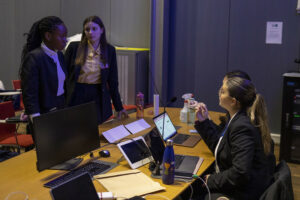Ferney-Voltaire Model United Nations (FerMUN) is a vast and rich ecosystem , where each role is unique and contributes to the diplomatic experience in different ways . One of the most complex roles which can be taken on by the young students is the role of a chair . In this article , we will discover everything that there is to know about this fascinating position, with insights from FerMUN 2025 chairs!
FerMUN’s goal is to bring together young students from all over the world to participate in diplomatic simulations that resemble the real United Nations as much as possible. All UN conferences are structured by several assemblies or committees . Each assembly or committee is presided by one or several individuals, typically referred to as chairs. At the heart of the debate, the chairs carry considerable responsibilities which determine the outcome of the debates, and therefore the conference as a whole.
“In my opinion, a chair is simultaneously implicated in the debate and also the organisation. Indeed, a chair has to know how to manage a debate well: speaking, points and motions, lobbying, amendments, the list goes on. But at the same time the chair has to be invested and implicated in the organisation of the conference, by writing a research report linked to an issue that will be debated later on by the delegates” – Rayan, a chair in terminale
Long before debates commence, chairs begin their hard work by preparing the issues that will be debated . They meticulously research the topic assigned to them and formulate two questions that the delegates will debate on. Once the questions are formulated, each chair consolidates their research and acquired knowledge by writing an in-depth research report . This report is an essential resource used by the delegates to understand the issue and begin forming their delegation’s position for the debate. It is an indispensable step of preparing the conference, the base that the debates are built on.
“Chairs are here to make sure that the debate moves forwards in a respectful environment in order to have the most successful exchange possible between the delegates.” -Mina, a chair in terminale
Once the conference has started, the chairs take on a new, difficult responsibility: managing dozens of delegates as well as the admins, translators and interpreters in their committee for three days . Chairs have to keep their eye on the clock to make sure that there will be enough time for icebreakers, lobbying, amendments, speeches and votes. Time management isn’t their only responsibility: they have to help their delegates in the right direction so that they can come up with innovative and interesting solutions to the issue at hand, all while collaborating with other delegates and having constructive debates as differences arise.
“Maintaining order is of course a priority of a chair , but a chair also has to remain friendly and polite towards everyone – no matter their role- and be reassuring if there are any issues .A good team is formed with a strong bond and trust between the members.” -Rania, chair in première.
All good chairs will agree that an encoraging and polite attitude is essential for a chair to have in order to have a successful conference. Indeed, a chair has to make sure to be friendly and sociable with their delegates, co-chairs, admins , translators and interpreters, as well as the other members of the board and FerMUN directors. By building connections and positive relationships with everyone, the chairs ensure that the conference unfolds smoothly in a calm environment , where each individual can make the most of a spectacular conference !
Marta Prokopchuk
